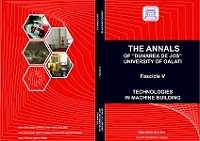INFLUENCE OF CUTTING PARAMETERS ON THE ROUGHNESS OF MACHINED SURFACES
Abstract
Aluminum-based alloys are increasingly used in the aeronautical, automotive,
defense, etc. industries. This has led to the development of research on the
machinability of these types of materials. Although aluminum is not considered to be
a material characterized by good machinability, there are among its alloys some
that stand out for this quality. This is the case of duralumin 2024 T351, which is an
alloy characterized by good mechanical strength, relatively high hardness and
corrosion resistance. These characteristics, combined with a low density of the
alloy, cause the material to be widely used in the aeronautical, automotive and
defense industries. Among the methods of processing parts made from 2024 T351,
machining is also used. One of the indicators of the quality of this type of processing
is the roughness of the chipped surface. In this paper we aim to identify which of the
parameters of the machining process has a more important influence on the
roughness obtained.


